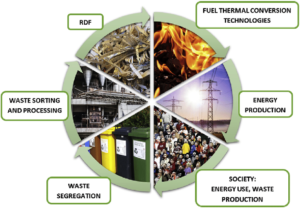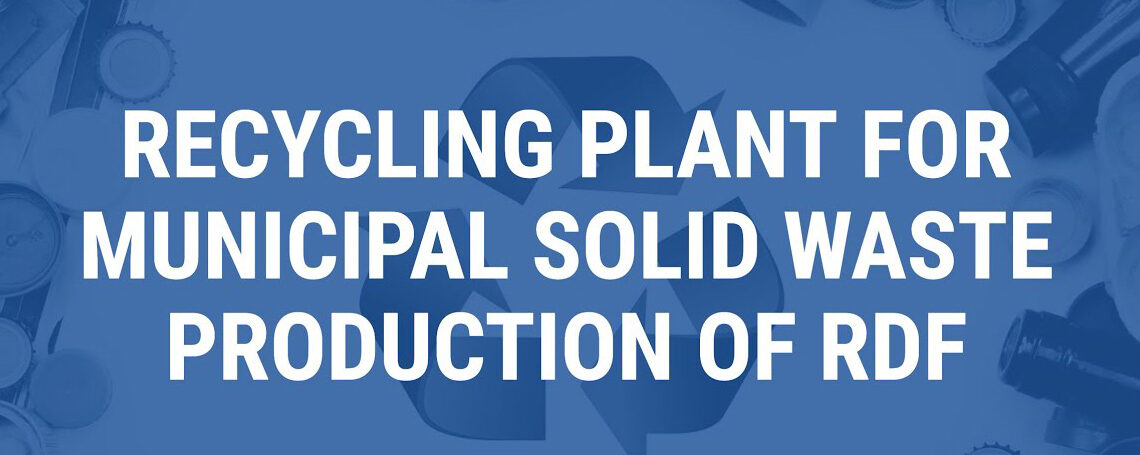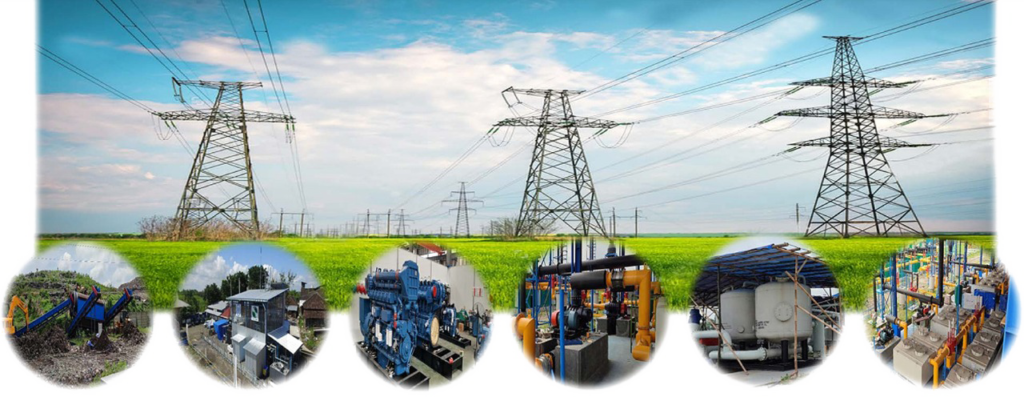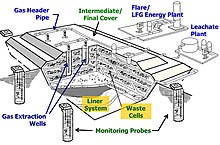Waste-to-energy plants burn municipal solid waste (MSW), often called garbage or trash, to produce steam in a boiler that is used to generate electricity. MSW is a mixture of energy-rich materials such as paper, plastics, yard waste, and products made from wood.
Worldwide there are various ways to create energy from waste – find below some information of the most common industrial processes to produce energy from waste – Source Wikipedia!
Incineration
…the combustion of organic material such as waste with energy recovery, is the most common WtE implementation. All new WtE plants in OECD countries incinerating waste (residual MSW, commercial, industrial or RDF) must meet strict emission standards, including those on nitrogen oxides (NOx), sulphur dioxide (SO2), heavy metals and dioxins. Hence, modern incineration plants are vastly different from old types, some of which neither recovered energy nor materials. Modern incinerators reduce the volume of the original waste by 95-96 percent, depending upon composition and degree of recovery of materials such as metals from the ash for recycling.
Incinerators may emit fine particulate, heavy metals, trace dioxin and acid gas, even though these emissions are relatively low from modern incinerators. Other concerns include proper management of residues: toxic fly ash, which must be handled in hazardous waste disposal installation as well as incinerator bottom ash (IBA), which must be reused properly.
Critics argue that incinerators destroy valuable resources and they may reduce incentives for recycling. The question, however, is an open one, as European countries which recycle the most (up to 70%) also incinerate to avoid landfilling.
Incinerators have electric efficiencies of 14-28%. In order to avoid losing the rest of the energy, it can be used for e.g. district heating (cogeneration). The total efficiencies of cogeneration incinerators are typically higher than 80% (based on the lower heating value of the waste).
The method of incineration to convert municipal solid waste (MSW) is a relatively old method of WtE generation. Incineration generally entails burning waste (residual MSW, commercial, industrial and RDF) to boil water which powers steam generators that generate electric energy and heat to be used in homes, businesses, institutions and industries. One problem associated is the potential for pollutants to enter the atmosphere with the flue gases from the boiler. These pollutants can be acidic and in the 1980s were reported to cause environmental degradation by turning rain into acid rain. Modern incinerators incorporate carefully engineered primary and secondary burn chambers, and controlled burners designed to burn completely with the lowest possible emissions, eliminating, in some cases, the need for lime scrubbers and electro-static precipitators on smokestacks.
By passing the smoke through the basic lime scrubbers, any acids that might be in the smoke are neutralized which prevents the acid from reaching the atmosphere and hurting the environment. Many other devices, such as fabric filters, reactors, and catalysts destroy or capture other regulated pollutants. According to the New York Times, modern incineration plants are so clean that “many times more dioxin is now released from home fireplaces and backyard barbecues than from incineration. According to the German Environmental Ministry, “because of stringent regulations, waste incineration plants are no longer significant in terms of emissions of dioxins, dust, and heavy metals”.
Compared with other waste to energy technologies, incineration seems to be the most attractive due to its higher power production efficiency, lower investment costs, and lower emission rates. Additionally, incineration yields the highest amount of electricity with the highest capacity to lessen pile of wastes in landfills through direct combustion.
Other Waste to Energy Technologies
There are a number of other new and emerging technologies that are able to produce energy from waste and other fuels without direct combustion. Many of these technologies have the potential to produce more electric power from the same amount of fuel than would be possible by direct combustion. This is mainly due to the separation of corrosive components (ash) from the converted fuel, thereby allowing higher combustion temperatures in e.g. boilers, gas turbines, internal combustion engines, fuel cells. Some are able to efficiently convert the energy into liquid or gaseous fuels:
Thermal treatment technologies:
- Gasification: produces combustible gas, hydrogen, synthetic fuels
- Thermal depolymerization: produces synthetic crude oil, which can be further refined
- Pyrolysis: produces combustible tar/biooil and chars
- Plasma arc gasification or plasma gasification process (PGP): produces rich syngas including hydrogen and carbon monoxide usable for fuel cells or generating electricity to drive the plasma arch, usable vitrified silicate and metal ingots, salt and sulphur
Non-thermal technologies:
- Anaerobic digestion: Biogas rich in methane
- Fermentation production: examples are ethanol, lactic acid, hydrogen
- Mechanical biological treatment (MBT)
- MBT + Anaerobic digestion
- MBT to Refuse derived fuel
Global Developments
During the 2001–2007 period, the waste-to-energy capacity increased by about four million metric tons per year. Japan and China each built several plants based on direct smelting or on fluidized bed combustion of solid waste. In China there are about 434 waste-to-energy plants in early 2016. Japan is the largest user in thermal treatment of municipal solid waste in the world, with 40 million tons. Some of the newest plants use stoker technology and others use the advanced oxygen enrichment technology. Several treatment plants exist worldwide using relatively novel processes such as direct smelting, the Ebara fluidization process and the Thermoselect JFE gasification and melting technology process. As of June 2014, Indonesia had a total of 93.5 MW installed capacity of waste-to-energy, with a pipeline of projects in different preparation phases together amounting to another 373MW of capacity.
Biofuel Energy Corporation of Denver, Colorado, opened two new biofuel plants in Wood River, Nebraska, and Fairmont, Minnesota, in July 2008. These plants use distillation to make ethanol for use in motor vehicles and other engines. Both plants are currently reported to be working at over 90% capacity. Fulcrum BioEnergy incorporated located in Pleasanton, California, is building a WtE plant near Reno, NV. The plant is scheduled to open in 2019 under the name of Sierra BioFuels plant. BioEnergy incorporated predicts that the plant will produce approximately 10.5 million gallons per year of ethanol from nearly 200,000 tons per year of MSW.
Waste to energy technology includes fermentation, which can take biomass and create ethanol, using waste cellulosic or organic material. In the fermentation process, the sugar in the waste is converted to carbon dioxide and alcohol, in the same general process that is used to make wine. Normally fermentation occurs with no air present.
Esterification can also be done using waste to energy technologies, and the result of this process is biodiesel. The cost effectiveness of esterification will depend on the feedstock being used, and all the other relevant factors such as transportation distance, amount of oil present in the feedstock, and others. Gasification and pyrolysis by now can reach gross thermal conversion efficiencies (fuel to gas) up to 75%, however a complete combustion is superior in terms of fuel conversion efficiency. Some pyrolysis processes need an outside heat source which may be supplied by the gasification process, making the combined process self-sustaining.
Carbon dioxide emissions
 In thermal WtE technologies, nearly all of the carbon content in the waste is emitted as carbon dioxide (CO2) to the atmosphere (when including final combustion of the products from pyrolysis and gasification; except when producing biochar for fertilizer). Municipal solid waste (MSW) contain approximately the same mass fraction of carbon as CO2 itself (27%), so treatment of 1 metric ton (1.1 short tons) of MSW produce approximately 1 metric ton (1.1 short tons) of CO2.
In thermal WtE technologies, nearly all of the carbon content in the waste is emitted as carbon dioxide (CO2) to the atmosphere (when including final combustion of the products from pyrolysis and gasification; except when producing biochar for fertilizer). Municipal solid waste (MSW) contain approximately the same mass fraction of carbon as CO2 itself (27%), so treatment of 1 metric ton (1.1 short tons) of MSW produce approximately 1 metric ton (1.1 short tons) of CO2.
In the event that the waste was landfilled, 1 metric ton (1.1 short tons) of MSW would produce approximately 62 cubic metres (2,200 cu ft) methane via the anaerobic decomposition of the biodegradable part of the waste. This amount of methane has more than twice the global warming potential than the 1 metric ton (1.1 short tons) of CO2, which would have been produced by combustion. In some countries, large amounts of landfill gas are collected. However, there is still the global warming potential of the landfill gas being emitted to atmosphere. For example, in the US in 1999 landfill gas emission was approximately 32% higher than the amount of CO2 that would have been emitted by combustion.
In addition, nearly all biodegradable waste is biomass. That is, it has biological origin. This material has been formed by plants using atmospheric CO2 typically within the last growing season. If these plants are regrown the CO2 emitted from their combustion will be taken out from the atmosphere once more.
Such considerations are the main reason why several countries administrate WtE of the biomass part of waste as renewable energy. The rest—mainly plastics and other oil and gas derived products—is generally treated as non-renewables.
Determination of the biomass fraction
MSW to a large extent is of biological origin (biogenic), e.g. paper, cardboard, wood, cloth, food scraps. Typically half of the energy content in MSW is from biogenic material. Consequently, this energy is often recognised as renewable energy according to the waste input.
Several methods have been developed by the European CEN 343 working group to determine the biomass fraction of waste fuels, such as Refuse Derived Fuel/Solid Recovered Fuel. The initial two methods developed (CEN/TS 15440) were the manual sorting method and the selective dissolution method. A detailed systematic comparison of these two methods was published in 2010. Since each method suffered from limitations in properly characterizing the biomass fraction, two alternative methods have been developed.
The first method uses the principles of radiocarbon dating. A technical review (CEN/TR 15591:2007) outlining the carbon 14 method was published in 2007. A technical standard of the carbon dating method (CEN/TS 15747:2008) is published in 2008. In the United States, there is already an equivalent carbon 14 method under the standard method ASTM D6866.
The second method (so-called balance method) employs existing data on materials composition and operating conditions of the WtE plant and calculates the most probable result based on a mathematical-statistical model. Currently the balance method is installed at three Austrian and eight Danish incinerators.
A comparison between both methods carried out at three full-scale incinerators in Switzerland showed that both methods came to the same results.
Carbon 14 dating can determine with precision the biomass fraction of waste, and also determine the biomass calorific value. Determining the calorific value is important for green certificate programs such as the Renewable Obligation Certificate program in the United Kingdom. These programs award certificates based on the energy produced from biomass. Several research papers, including the one commissioned by the Renewable Energy Association in the UK, have been published that demonstrate how the carbon 14 result can be used to calculate the biomass calorific value. The UK gas and electricity markets authority, Ofgem, released a statement in 2011 accepting the use of Carbon 14 as a way to determine the biomass energy content of waste feedstock under their administration of the Renewables Obligation. Their Fuel Measurement and Sampling (FMS) questionnaire describes the information they look for when considering such proposals.



